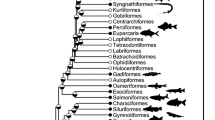Abstract
Mytilus edulis L. heterozygotes with a null allele at the octopine dehydrogenase (Odh) locus or an allele coding for low activity at the glucose phosphate isomerase (Gpi) locus were found to grow significantly faster (p(0.05) than other juvenile mussels in the same laboratory cultures. Odh null homozygotes were not significantly different in growth from mussels with active Odh alleles. No additive effects were seen in individuals which had both the Odh null allele and the allele coding for low GPI activity. These results do not support the contention that null alleles are a significant cause of the observed correlation between multiple-locus heterozygosity and fitness in mussels. The apparent deficiencies of heterozygotes against Hardy-Weinberg expectations observed at the Odh locus in two Netherlands M. edulis populations can be more than accounted for by the null-allele frequency calculated, assuming Hardy-Weinberg equilibrium, from the observed frequency of null homozygotes in these populations.
Similar content being viewed by others
References
Allendorf FW, Knudsen KL, Blake GM (1982) Frequencies of null alleles at enzyme loci in natural populations of ponderosa and red pine. Genetics, Austin, Tex 100: 497–504
Bayne BL (1965) Growth and the delay of metamorphosis of the larvae of Mytilus edulis L. Ophelia 2: 1–47
Beaumont AR (1991) Genetic studies of laboratory reared mussels, Mytilus edulis: heterozygote deficiencies, heterozygosity and growth. Biol J Linn Soc 44: 273–285
Brunetti R, Gabriele M, Valerio P, Fumagalli O (1992) The micronucleus test: temporal pattern of baseline frequency in Mytilus galloprovincialis. Mar Ecol Prog Ser 83: 75–78
Dixon DR (1982) Aneuploidy in mussel embryos (Mytilus edulis L.) originating from a polluted dock. Mar Biol Lett 3: 155–161
Dixon DR, Clarke KR (1982) Sister chromatid exchange: a sensitive method for detecting damage caused by exposure to environmental mutagens in the chromosomes of adult Mytilus edulis. Mar Biol Lett 3: 163–172
Freeth AL, Gibson JB, de Couet HG (1986) The partial characterization of alcohol dehydrogenase null alleles from natural populations of Drosophila melanogaster. Biochem Genet 24: 957–972
Gäde G (1980) Biological rôle of octopine formation in marine molluscs. Mar Biol Lett 1: 121–135
Gaffney PM (1994) Heterosis and heterozygote deficiencies in marine bivalves: more light? In: Beaumont AR (ed) Genetics and evolution of aquatic organisms. Chapman & Hall, London, pp 146–153
Hoare K, Beaumont AR, Davenport J (1994) Effects of copper exposure during early life stages on heterozygosity in laboratory-reared populations of the mussel, Mytilus edulis L. In: Beaumont AR (ed) Genetics and evolution of aquatic organisms. Chapman & Hall, London, pp 459–466
Katoh M, Foltz DW (1987) Leucine aminopeptidase specific activity is significantly reduced in Lap null heterozygous oysters (Crassostrea virginica). Genetics, Austin, Tex 116 (Suppl)
Langley CH, Voelker RA, Leigh Brown AJ, Ohnishi S, Dickson B, Montgomery E. (1981) Null allele frequencies at allozyme loci in natural populations of Drosophila melanogaster. Genetics, Austin, Tex 99: 151–156
Mallet AL, Zouros E, Gartner-Kepkay KE, Freeman KR (1986) Genetics of growth in blue mussels: family and enzyme-heterozygosity effects. Mar Biol 92: 475–482
Mallet AL, Zouros E, Gartner-Kepkay KE, Freeman KR, Dickie LM (1985) Larval viability and heterozygote deficiency in populations of marine bivalves: evidence from pair matings of mussels. Mar Biol 87: 165–172
Rice WR (1989) Analyzing tables of statistical tests. Evolution 43: 223–225
Sclander RK (1970) Behaviour and genetic variation in natural populations. Am Zool 10: 53–66
Siegel S (1956) Non-parametric statistics for the behavioural sciences. McGraw-Hill, New York
Sokal RR, Rohlf FJ (1981) Biometry. The principles and practice of statistics in biological research. 2nd edn. WH Freeman & Co, New York
Zouros E (1987) On the relationship between heterozygosity and heterosis: an evaluation of the evidence from marine mollusks. Isozymes. Curr Topics biol med Res 15: 255–270
Zouros E, Mallet AL (1989) Genetic explanations of the growth/heterozygosity correlation in marine mollusks. In: Ryland JS, Tyler PA (eds) Reproduction, genetics and distributions of marine organisms. Olsen & Olsen, Fredensborg, pp 317–324
Zouros E, Pogson GH (1994) The present status of the relationship between heterozygosity and heterosis. In Beaumont AR (ed) Genetics and evolution of aquatic organisms. Chapman & Hall, London, pp 135–146
Zouros E, Singh SM, Miles HE (1980) Growth rate in oysters: an overdominant phenotype and its possible explanations. Evolution 34: 856–867
Author information
Authors and Affiliations
Additional information
Communicated by J. Mauchline, Oban
Rights and permissions
About this article
Cite this article
Hoare, K., Beaumont, A.R. Effects of an Odh null allele and a GPI low-activity allozyme on shell length in laboratory-reared Mytilus edulis . Marine Biology 123, 775–780 (1995). https://doi.org/10.1007/BF00349120
Received:
Accepted:
Issue Date:
DOI: https://doi.org/10.1007/BF00349120




